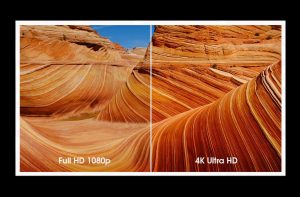360p, 480i, 480p, 720p, 1080i, 1080p.
If those numbers mean anything to you, congratulations! You have a basic knowledge of the resolutions of video. You probably don’t need me to tell you this, but the resolutions start from the lowest definition to the highest. 360p is the lowest. Well, I should say lowest tolerable resolution. Any lower, and you might as well be watching the video wearing drunk goggles. YouTube is now offering 140p resolution, which is intended for users with impossibly slow connection speeds. Resolutions below 360p are fairly new to the world of YouTube, but I’m not here to talk about moving backwards with our video quality. Being the open minded, pretentious hippie that I am, I’m here to talk about PROGRESSION! 4K video is here. It’s being rolled out slowly, but it’s going to change things in a big way.
Numbers like 480, 720, and 1080 refer to the number and distribution of pixels. 1080p (the current high definition standard) means that the video has 1,080 pixels of vertical resolution. From the bottom of the image to the top, if you developed super pixel-counting powers, you would find 1,080 of them. Typically, to keep the widescreen format our eyes are used to, (the 16:9 format) the horizontal resolution will be 1,920 pixels. 4K video is almost 4 times as many pixels with a format of 3840 x 2160. That means the images produced will be 4 times larger than we’re typically used to. These images will be much sharper, and have much richer, deeper colors. This will totally redefine “hi definition”.

The nerd in me is incredibly excited, but the videographer in me is unsure. When I got started in video production, HD was already the standard. We still have an old school refrigerator-style HDTV at my house from back when the Patriots won the Superbowl in 2002. I’m racking my brain trying to remember what the transition was like, and I remember it being a slow one. I mean, you can still watch TV today and see commercials airing in standard def, 4X3 picture. So, my question is, how long before 4K becomes the standard? My guess is it will start with Hollywood. We’ll be able to see films shot in 4K HD, (Avatar sequel anyone?) and get our fix there first. Then, I imagine, like the switch to HD, people will slowly begin to purchase 4K capable televisions as the technology becomes more readily available and affordable.
My concern lies in the speed of the change-over to 4K. The rate at which technology is improving in every aspect of our society is staggering. Every year it gets faster, and every year, some new form of mind-blowing technology that was previously reserved for science fiction movies, becomes available to us as consumers. Don’t believe me? Well, consider that right now, in 2013, there are people who have figured out a way to fly a helicopter with your mind and scientists have figured out how to genetically modify spider silk to create bulletproof human skin.
So where does that put Anchor Line and all other independent video production companies? The switch to 4K will not be cheap. Not only will we have to invest in cameras that can shoot 4K, but we’ll need new computers, monitors, and storage devices that are able to handle the massive amounts of data from these files. When you consider the fact that your run of the mill, professional HD video camera, that in its highest resolution shoots 1080p, still goes for about $5,000, it makes my head spin to think about switching. I asked Adam what he thought about this and his response was, (joking I hope) “Maybe that’s the time we get out of the video industry.”
Overall, I am hopeful. I think companies understand that most of us won’t be immediately willing to drop absurd amounts of money to upgrade. There are already 4K TVs out there that are priced at about $1,000, the next generation of gaming consoles are 4K ready, and the new Samsung Galaxy S4 smartphone can already shoot in 4K (c’mon Apple, you’re slacking…) The good news is that the pricing of this technology is fairly comparable to what 1080p video hardware was when it hit the market–maybe even a little cheaper.
If there’s one thing I’ve learned about humanity, it’s that we adapt. We adapt to viruses, changes in climate, and the progression of technology. And if there’s one thing I know about Anchor Line, it’s that we are made up of robots humans. So, by the transitive property of adaptation, I can only conclude that we will adapt to the switch in 4K just as the rest of the population does. It’s coming folks, be prepared!


